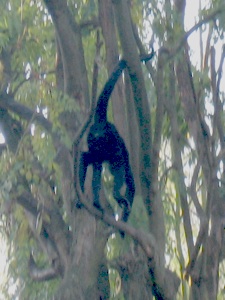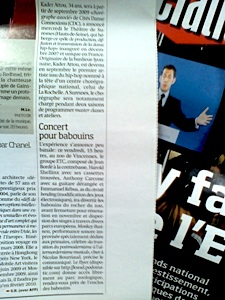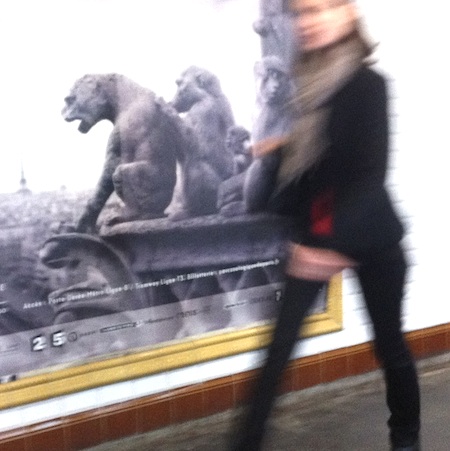11 min read 🤓
Monkey Business, Etc ...
december 01, 2008.
" ... [P]eople say we monkey around.
But we're too busy singing
To put anybody down ... "
( * )
As the picture below will convincingly show, even though it was a friday
and almost raining, for our performance dedicated to the primates
living in the parisian zoological garden, the Zoo
de Vincennes, on the afternoon of november 24th, we came at our sunday's
best.
That of course was, 1st: because this was an extraordinary, a "we will do this only once"
occasion, and 2nd: also a matter of showing respect for our audience.
(Note of warning: dear viewer, please refrain from the too obvious
conclusion that I must be joking, or am being cynical here or in that what
follows ... That conclusion is too simple. Fortunately and interestingly things in most cases are not that simple.)
 |
The unusual event at the zoo was Anthony Carcone's brainchild. Anthony
(on the left in the picture) actually lives more or less across the road
from the zoo, and I had heard him mention before that he would love
to one day perform there for the animals.
Starting from the end of november 2008, the Vincennes Zoo will close for
a period of near to three years, during which the often badly degraded concrete
structures housing the animals will be renovated, and the animals themselves
are sent out lodging in other european 'animal gardens'. This fact set Anthony
into action: he managed to convince the zoo's management how much it would
be magic to offer a farewell concert, of 'experimental', improvised, music
to the zoo's community of baboons
...
 |
 |
Now these were no vain words, and the event for all there present and involved indeed did turn out to be as close to 'magic' as one can possibly get.
It was a bumpy road, though.
All started with a long lasting confusion about the precisely when, the exactly who and how of the performance. When all of these practicalities finally had been settled, a mere couple of days before the event there appeared a blog-entry about it as part of the popular critical & left-wing news web site Rue 89, that we thought was sort of innocent and fun, but that appeared to have enraged the zoo's management because of what they considered its "vulgar language" and "disrespect for the animals".
The zoo's management threatened to cancel the event, and it was only less than a day before that for some reason they again chanced their minds and we were sure that we would be allowed to enter and perform ...
 |
 |
I went to the zoo with Anthony early morning of the day before the concert,
thursday 23rd. We tried to convince the person in charge of our non-involvement
in the writing of the blog article, but didn't seem to be very successful
at it. The discussion that morning left the 'yes' or 'no' of our Monkey
Business, planned for the next day, pretty much in suspense. It therefore
was with something of a heavy heart that we subsequently went to visit the baboons'
rock, to do some sound recording and see how we might best set up there
for the event ... in case we still would be permitted to make it happen.
When we arrived the apes had not yet left their night quarters. Their rocky playground (made out of concrete) was deserted.
But Chimène was there.
Chimène is a single female Gibbon who is solitarily living opposite the baboons' rock, on a small artificial island in one of the zoo's ponds. Chimène has been refusing mates for all of her life, and is known to be extremely shy. She is notorious for her stubbornly getting out of sight and hiding as soon as she becomes beware of attention that is specifically directed at her, like camera's watching, etc.
One of the reasons for being there that early, was that we had been told
that early in the morning Chimène sings. The Gibbon was sitting
somewhere high up in one of the trees, but apart from the nice but sort
of run-of-the-mill city zoo-ish soundscape with its low rumbling background
of traffic noise, we did not hear anything special. So we soon stopped paying
attention to Chimène, and our main focus became the community of baboons,
that suddenly came out en masse. Without much further
ado, the apes braced themselves for another long day of screaming, jumping, fleaing
and fucking around.
And then, while we were attentively watching the baboons going on about their business, suddenly
from behind us, that amazing cry came rolling over ....
It was Chimène, and she was singing.
 |
 |
Our friday's concert was in two parts. All the time, from somewhere on the side line, a primatologist was watching. She was to keep an eye on the monkeys, in order to interfere and stop us, should we, our music or both agitate the primate audience, or otherwise provoke unusual reactions from the apes ...
We first directed our performance at the baboons.
Then, for a second set, we turned, and played for Chimène.
We had been asked not to play back to the baboons recordings of their own cries and sounds, as the primatologist thought there was a high risk that that would make them aggressive. She did not object though to playing Chimène's chanting back to her ... And so when we started our performance for Chimène the Gibbon, I began by playing back to her my dictaphone recordings of her singing the day before. That was a very special moment, though shy Chimène herself stayed as far away as possible from it all.
She had us do our monkey business all alone ...
You can listen and watch some extracts of our performance for Chimène in the uTube signed Rébus below. It gives you an impression of how the sounds of the zoo around us mixed in with the sounds of our making ... (We will prepare a more extensive documentary film on 'Monkey Business' later, so stay tuned.)
We were especially pleased when after the concert it appeared that that human part of the audience that actually was employed at the Zoo, turned out to be absolutely enchanted by the 'happening'. Though none of them had any knowledge whatsoever of so-called 'experimental' improvised musics, and would, nor will, ever set foot in any of the places where this type of music in general is performed, they were raving about the event and the 'picture of sounds' that we generated there, for them - and for the monkeys.
This is extremely important of course. And I do hope that regular viewer at this pont will begin to appreciate how, maybe contrary to first appearances and despite the evident differences, at heart this entry is intimately related to the previous one, and to the one before that ...
One of the main challenges the contemporary improvising postmusician faces is to find ways that will take his music and performing outside of its habitat, his 'peer-circuit': the collection of clubs and venues organizing concerts that are mainly attended by other improvising postmusicians. The regular viewer will know that a such 'coming out' is one of the principles guiding Rébus's AntiNoise Brigades, it is what lead Diktat to play on the Scheveningen beach and on Marinus Boezem's public soundsculpture in Breda... ( ** )
In his explications to journalists Anthony stressed the gesturality involved in our performing in general, and even more so in the taking of such a performance to the apes. A gesturality that indeed includes not only the acts of movement, psychological states and ideas active at the moment of presenting and 'giving' the work to its attendees, but also encompasses the complete set of requisite operations for the production of its peripheral signs. (Like, for example, the writing of this article ...)
All of this fits remarkably well into the framework of what Nicolas
Bourriaud calls relational
aesthetics,
which designates the emerging set of artistic practices that take (inter-human
/ inter-cultural) relations as a starting point, and hence firmly
position themselves within a social context, rather than within
an independent and private space.
And while Monkey business would full heartedly confess adhering to what might be interpreted as a definitely 'postmodern impetus', it is far from being cynical. Even though I do not consider 'cynicism' to be a necessary attribute of each and every thing 'postmodern', maybe rather than being classified as such, it should be taken as indicative of the new modernity that according to some critics and historians of art is dawning, and that Nicolas Bourriaud has baptized altermodern.
It is thus that we thought it appropriate to mention in our announcements
that, in its own modest way, Monkey Business would herald the death
of postmodernism and the subsequent transition of contemporary art into
the new altermodern era. ( *** )
A reporter from France
Inter who interviewed us in the Zoo doubted very much that
we were serious about this, even though I assured him that we were,
once, twice and then thrice ... The short item around Monkey Business that he produced and that was broadcast by
France Inter the next morning in their emission
'sept-neuf', didn't mention 'altermodernity' in whatever way. It nevertheless was
an absolutely
delightful
coincidence, that said program, broadcast in the early morning of saturday october 25th, had as its theme "Que veut dire
l'art contemporain?" ('What is the meaning of contemporary art?' or rather: "What does contemporary art want to say?"),
with Nicolas Bourriaud as its special live guest ...
 |
 |
Thus Monkey Business got its share of - transitory - media attention. Our performance zapped by as one of the items in the 'Six Minutes' of faits divers on friday evening around 20h at the M6 television channel; it was announced on the 'Culture pages' of friday's Libération (see picture above), and found its way into several editions of the Parisien; there was the short reportage on France Inter, and a longer one - still upcoming - on France Culture ...
As soon as we left the Zoo, it began to rain ...
...
- next: Elderly artists, some of them sleeping -
More Monkey Music:
Monkeys Don’t Go For Music — Unless It’s Made for Them (Wired, sept. 2009)
Added April 12th 2014:
__They're back! And boy, are we ready for them!
notes __ ::
(*) From the lyrics to 'Theme from The
Monkees' (written by Tommy Boyce and Bobby Hart), the tune of the american 1960s situation comedy
The
Monkees. [ ^ ]
(**) It also guided the belgian-french Brocante
Sonore, whose principal 'concert hall' for a long time was any willing person's living room.
Since I first met the Brocante, somewhat over a year ago in Brussels,
we gradually slipped into an interesting symbiosis,
in which La Brocante's Anthony Carcone continues to manifest an extraordinary
talent for unearthing unlikely places, that turn out as highly rewarding
places to perform ...
 It was Anthony who, in february of this year, took us chez
Fukiko, a Japanese hairdresser in the center of Vincennes.
We performed a second time in Fukiko's saloon, on the saturday
evening of september 20th when four of us (Jean Bordé - double bass, Anthony
Carcone - deranged guitar, Jacques Foschia - tube radio's and me - dictaphones)
were the Sextet des Envierges, that the evening before had performed
at La Veilleuse as a quintet, together with Rébus.
It was Anthony who, in february of this year, took us chez
Fukiko, a Japanese hairdresser in the center of Vincennes.
We performed a second time in Fukiko's saloon, on the saturday
evening of september 20th when four of us (Jean Bordé - double bass, Anthony
Carcone - deranged guitar, Jacques Foschia - tube radio's and me - dictaphones)
were the Sextet des Envierges, that the evening before had performed
at La Veilleuse as a quintet, together with Rébus.
--[[ The Sextet des Envierges came into being especially for this
performance, september 19th, 2008, at La Veilleuse, to mark the  fact
that later that month Julien, the 'innkeeper', would leave and move to Lille.
La Veilleuse will close down for a while, to be redecorated. It is intended
to reopen early 2009, but of course will never be the same again. The name of
the ad hoc ensemble derives from the name of the street where La
Veilleuse is situated. We had intended it to be a sextet, and include trombone
player Pierre Chabrèle, who was in the audience at La Veilleuse
fact
that later that month Julien, the 'innkeeper', would leave and move to Lille.
La Veilleuse will close down for a while, to be redecorated. It is intended
to reopen early 2009, but of course will never be the same again. The name of
the ad hoc ensemble derives from the name of the street where La
Veilleuse is situated. We had intended it to be a sextet, and include trombone
player Pierre Chabrèle, who was in the audience at La Veilleuse  when on sunday september 7th Jacques Foschia, Anthony Carcone and myself
did a trio performance there. At some point Pierre took the embouchure
of his instrument and entered in a spontaneous duet with the sounds of my
cracklebox. Unfortunately he could not make it that friday. Therefore the sextet
performed as a quintet. On saturday, chez Fukiko, it performed as a quartet.
The next day, sunday september 21st, the Sextet des Envierges was
disbanded. Until we meet again. ]]--
when on sunday september 7th Jacques Foschia, Anthony Carcone and myself
did a trio performance there. At some point Pierre took the embouchure
of his instrument and entered in a spontaneous duet with the sounds of my
cracklebox. Unfortunately he could not make it that friday. Therefore the sextet
performed as a quintet. On saturday, chez Fukiko, it performed as a quartet.
The next day, sunday september 21st, the Sextet des Envierges was
disbanded. Until we meet again. ]]--
Second time we performed chez Fukiko saw us profiting even more from
the specifics of the spot. We did two sets seated
in Fukiko's bright yellow leather barber chairs and looking into the round mirrors,
with the 'inexperienced' but very attentive and appreciative audience watching
and listening behind our backs. There was also tasty japanese food, lots
to drink, japanese songs, and a young magician doing amazing tricks. The kid
had stuff disappear while I was closely watching his every move from no
further than 10 or 20 centimeters away ... [
^ ]
(***) This incited the
following delightful reader comment to the blog
post at Rue 89, to which at a future moment we will surely be happy
to respond: "Pour jouer l’altermodernisme à une bande de babouins, installez-vous
devant l’Assemblée Nationale ..." [ ^ ]
tags: Vincennes, zoo, primatology, altermodern, postmodern, relational aesthetics, postart, monkeys
# .284.
smub.it | del.icio.us | Digg it! | reddit | StumbleUpon
comments for Monkey Business, Etc ... ::
|
Comments are disabled |
